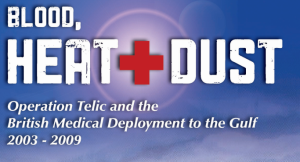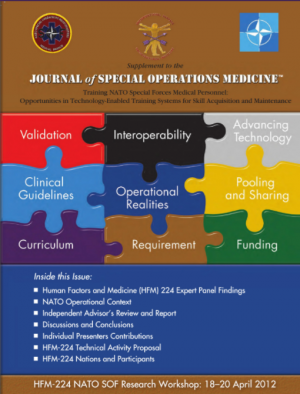26/11/2017
Combat and casualty care
15/11/2017
XStat versus Quikclot: Pas de différence de survie
Evaluation of XSTAT® and QuickClot® Combat Gauze® in a Swine Model of Lethal Junctional Hemorrhage in Coagulopathic Swine.
BACKGROUND:
Hemorrhage is associated with most potentially survivable deaths on the battlefield. Effective and field-tested products are lacking to treat junctional and noncompressible injuries. XSTAT® is a newly developed, U.S. Food and Drug Administration-approved product designed to treat junctional hemorrhage. The Committee on Tactical Combat Casualty Care has recently approved the product for use as part of its treatment guidelines, but data are lacking to assess its efficacy in different wounding patterns and physiologic states.
METHODS:
Dilutional coagulopathy was induced in 19 large (70-90kg), healthy, male swine by replacing 60% of each animal's estimated blood volume with room temperature Hextend ®. After dissection, isolation, and lidocaine incubation, uncontrolled hemorrhage was initiated by transection of both axillary artery and vein. Free bleeding was allowed to proceed for 30 seconds until intervention with either XSTAT or QuickClot® Combat Gauze® (CG) followed by standard backing. Primary outcomes were survival, hemostasis, and blood loss.
RESULTS:
XSTAT-treated animals achieved hemostasis in less time and remained hemostatic longer than those treated with CG. Less blood was lost during the first 10 minutes after injury in the XSTAT group than the CG group. However, no differences in survival were observed between XSTAT-treated and CG-treated groups. All animals died before the end of the observation period except one in the XSTAT-treated group.
CONCLUSION:
XSTAT performed better than CG in this model of junctional hemorrhage in coagulopathic animals. Continued testing and evaluation of XSTAT should be performed to optimize application and determine appropriate indications for use.
| Tags : hémorragie, pansement
14/11/2017
Balles en caoutchouc: Pas si anodines !
------------------------------
Cet article ne fait que confirmer le fait que certaines munitions en caoutchouc sont dangereuses (1) voire mortelles (2). Les lésions rapportées sont ici périphériques mais tout peut se voir: Atteintes faciales (3);oculaires (4), thoraciques (5), crâniennes (6), vasculaires (7). Evidemment cela dépend du type de munitions employées qui sont d'une grande variété.
------------------------------
Rubber bullets are considered a non-lethal method of crowd control and are being used over the world. However the literature regarding the pattern and management of these injuries is scarce for the forensic pathologist as well as for the traumatologist. The objective of this report was to add our experience to the existing literature.
METHODS:
From June 2008 to August 2010 the Government Hospital for Bone and Joint Surgery Barzulla and the Department of Orthopaedics, SKIMS Medical College/Hospital Bemina Srinagar received 28 patients for management of their orthopaedic injuries caused by rubber bullets. We documented all injuries and also recorded the management issues and complications that we encountered.
RESULTS:
All patients weremales with an age range of 11-32 years and were civilians who had been hit by rubber bullets fired by the police and the paramilitary forces. Among them, 19 patients had injuries of the lower limbs and 9 patients had injuries of the upper limbs. All patients were received within 6 h of being shot.
CONCLUSION:
Our findings suggest that these weapons are capable of causing significant injuries including fractures and it is important for the surgeon to be well versed with the management of such injuries especially in areas of unrest. The report is also supportive of the opinion that these weapons are lethal and should hence be reclassified.
13/11/2017
les "Brit" en Irak 2003
A quoi sert un médecin ?
The Role Of The Physician In Modern Military Operations: 12 Months Experience In Southern Iraq
Grainge C et Al. J R Army Med Corps 2005 151: 101-1
--------------------------------------
Vaste débat surtout pour nous français élevé à la sauce de l a médecine préhospitalière type SAMU. D'autres ont une vision bien différente qui, bien qu'elle évolue (1) avec le concept de "prolonged field care" - ie: une certaine médicalisation de l'avant -, n'est globalement pas remise en cause après les engagements US et UK en irak et en afghanistan. Dans ce travail il apparait que les problématiques d'hygiène et de médecine de prévention, le préhospitalier n'est pas mentionné, sont pour nos alliés anglais au coeur du rôle de leurs médecins. On rappelle juste qu'ils sont aussi les adeptes de MEDEVAC très performantes - les MERT-Enhanced (équipes composées d'un médecin anesthésiste ou urgentiste expérimenté en matière de trauma, d'un-e infirmier-ère, de deux paramedics et d'une équipe de protection oeuvrant dans un Chinook CH-47.
--------------------------------------
Objectives To examine the profile of medical morbidity and the role of the physician in modern conflict.
Methods Retrospective survey of admission records at a British Military Field Hospital on operational duty in Southern Iraq.
Results 62.5% of 4870 admissions to the Field Hospital in Shaibah during the first 12 months of military operations in Iraq were under the care of physicians. Of these 1531 (31.4%) were due to diarrhoea and vomiting (D&V) and 764 (15.7%) due to heat illness. The incidence of heat illness rose with ambient temperature, but soldiers were more likely to be admitted with heat illness shortly after arrival in theatre than when fully acclimatised. There was also a steady flow of admissions with a broad spectrum of medical pathology requiring the clinical skills of a general physician.
Conclusions A general physician is a necessary part of the clinical team in modern conflict. The incidence of D&V and of heat illness on military operations remains high. Planners for any operation in tropical climates should take this into consideration and put preventative measures into place early.
12/11/2017
Retex du soutien d'une opération aéroportée
-----------------------------
Un publication déjà ancienne, mais l'expérience rapportée est assez unique et porte sur l'emploi d'une antenne chirurgicale et des conditions d'emploi lors des premières heures.
-----------------------------
Flying directly from its home station in Vicenza, Italy, the 173rd Airborne Brigade committed itself to the invasion of Iraq on the night of March 26, 2003. Representing the establishment of a northern front, approximately 1,000 paratroopers jumped into an isolated valley on a mission to secure and to hold the Bashur airstrip. This article describes the unique challenges of medical preparation for the mission, injuries sustained on the jump, and lessons learned. Emphasis is placed on the use of a policy of delayed evacuation until clarification of diagnosis.
Lunettes de vision nocturne: Une aide ? A voir !
-----------------------------------
Des résultats bien étonnants quand on connait les problèmes de profondeur de champ inhérents à l'emploi de dispositifs de vision nocturne, surtout monoculaires. Comme toujours maîtriser le geste en conditions normales, maîtriser l'outil de vision et s'entraîner dans ces conditions. Lire également 1, 2, 3
-----------------------------------
BACKGROUND:
In the patients with multiple and serious trauma, early applications of life-saving procedures are related to improved survival. We tried to experimentally determine the feasibility of life-saving interventions that are performed with the aid of night vision goggles (NVG) in nighttime combat scenario.
METHODS:
Chest tube thoracostomy (CTT), emergency cricothyroidotomy (EC), and needle thoracostomy (NT) interventions were performed by 10 combatant medical staff. The success and duration of interventions were explored in the study. Procedures were performed on the formerly prepared manikins/models in a bright room and in a dark room with the aid of NVG. Operators graded the ease of interventions.
RESULTS:
All interventions were found successful. Operators stated that both CTT and EC interventions were more difficult in dark than in daytime (p<0.05). No significant difference was observed in the difficulty in the NT interventions. No significant difference was observed in terms of completion times of interventions between in daytime and in dark scenario.
CONCLUSION:
The operators who use NVGs have to be aware of that they can perform their tactic and medical activities without taking off the NVGs and without the requirement of an extra light source.
| Tags : vision nocturne
10/11/2017
Formation des personnels des FS: Réflexions OTAN
Prolonged field care: Dans la vrai vie
A survey distributed to US military medical providers solicited details of PFC encounters lasting more than 4 hours and included patient demographics, environmental descriptors, provider training, modes of transportation, injuries, mechanism of injury, vital signs, treatments, equipment and resources used, duration of PFC, and morbidity and mortality status on delivery to the next level of care. Descriptive statistics were used to analyze survey responses.
RESULTS:
Surveys from 54 patients treated during 41 missions were analyzed. The PFC provider was on scene at time of injury or illness for 40.7% (22/54) of cases. The environment was described as remote or austere for 96.3% (52/54) of cases. Enemy activity or weather also contributed to need for PFC in 37.0% (20/54) of cases. Care was provided primarily outdoors (37.0%; 20/54) and in hardened nonmedical structures (37.0%; 20/54) with 42.6% (23/54) of cases managed in two or more locations or transport platforms. Teleconsultation was obtained in 14.8% (8/54) of cases. The prehospital time of care ranged from 4 to 120 hours (median 10 hours), and five (9.3%) patients died prior to transport to next level of care.
CONCLUSION:
PFC in the prehospital setting is a vital area of military medicine about which data are sparse. This review was a novel initial analysis of recent US military PFC experiences, with descriptive findings that should prove helpful for future efforts to include defining unique skillsets and capabilities needed to effectively respond to a variety of PFC contingencies.
| Tags : prolonged field care



